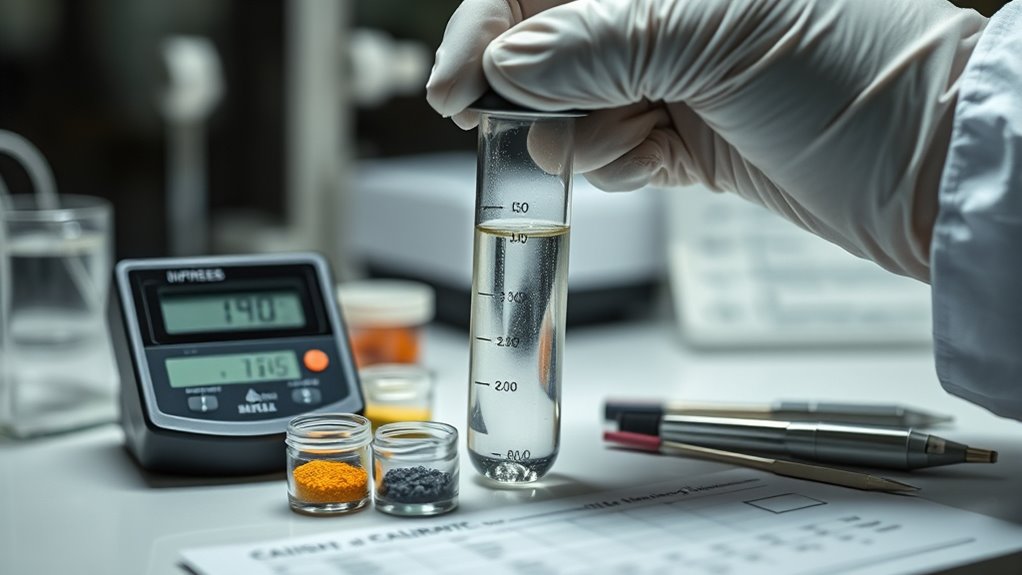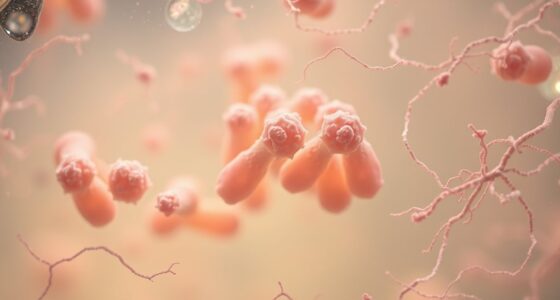To manage pharma impurities effectively, follow ICH guidelines like Q3A and Q3B that specify impurity identification, qualification, and control strategies. You should develop and validate analytical methods such as HPLC or MS to detect impurities early. Regular monitoring ensures your processes stay within established limits and comply with regulatory standards. Implement proactive measures to prevent contamination, maintaining drug safety and quality. Continuing further will help you fully understand ideal control strategies and compliance essentials.
Key Takeaways
- ICH guidelines Q3A and Q3B provide standards for identifying, qualifying, and controlling impurities in pharmaceuticals.
- Establish impurity limits based on toxicological risk assessments aligned with ICH recommendations.
- Use validated analytical methods like HPLC, GC, and MS for accurate impurity detection and quantification.
- Implement proactive impurity control strategies throughout manufacturing and storage processes.
- Regularly review and update impurity profiles to ensure ongoing compliance with ICH standards and product safety.

Pharma impurities are unwanted substances that can contaminate medications during manufacturing or storage, potentially affecting their safety and efficacy. Identifying and controlling these impurities is essential to ensure drugs meet quality standards and protect patient health. To achieve this, you need to rely on robust analytical techniques that can detect even trace levels of impurities with high accuracy and sensitivity. Techniques like high-performance liquid chromatography (HPLC), gas chromatography (GC), and mass spectrometry (MS) are commonly employed to characterize impurities, quantify their levels, and confirm that they stay within acceptable limits. These advanced methods allow you to monitor impurities throughout the production process, guaranteeing consistent quality and compliance with stringent regulatory requirements. Additionally, understanding impurity profiles helps in optimizing manufacturing processes to minimize contamination risks.
Robust analytical techniques like HPLC, GC, and MS are essential for detecting and controlling pharma impurities.
Regulatory compliance plays a critical role in impurity control, especially when adhering to ICH guidelines. These international standards provide a clear framework for identifying, qualifying, and controlling impurities in pharmaceuticals. As someone involved in drug development or manufacturing, you must understand and implement these guidelines to meet regulatory expectations. This includes establishing impurity specifications, conducting risk assessments, and performing stability studies to determine impurity profiles over time. The goal is to demonstrate that impurities are controlled at levels that do not compromise drug safety or efficacy. When your methods align with regulatory standards, you minimize the risk of rejection or delays during approval processes and ensure your product can enter the market smoothly.
Incorporating the principles of ICH Q3A and Q3B guidelines helps you develop a detailed impurity profile for your drug substances and products. You’re expected to identify potential impurities—such as residual solvents, process-related impurities, and degradation products—and establish acceptable limits based on toxicological data. Regularly reviewing and updating these limits according to stability data and manufacturing changes is necessary to maintain compliance. Additionally, your analytical techniques must be validated to prove their reliability and reproducibility, further supporting regulatory submissions.
Controlling pharma impurities is an ongoing process that requires vigilance, precision, and adherence to regulatory frameworks. By employing advanced analytical techniques and aligning your processes with ICH guidelines, you ensure your medications are safe, effective, and compliant with global standards. This proactive approach helps prevent issues before they reach consumers, safeguarding public health and maintaining your reputation as a quality-focused manufacturer. Ultimately, understanding and implementing effective impurity control strategies aren’t just regulatory necessities—they’re fundamental to delivering high-quality medicines that patients can trust.
Frequently Asked Questions
How Are Impurity Limits Determined for New Drug Substances?
You determine impurity limits for new drug substances through impurity profiling and risk assessment. You analyze the impurities present, their levels, and potential impact on safety and efficacy. Based on this data, you set limits that guarantee quality and compliance. Risk assessment helps you identify which impurities need stricter control, considering their toxicity, formation likelihood, and exposure risk, ensuring patient safety and regulatory adherence.
What Are the Latest Updates to ICH Impurity Guidelines?
You should review the latest ICH guidelines, which emphasize impurity profiling and regulatory harmonization. Recent updates focus on refining analytical methods, setting clearer limits, and aligning international standards to guarantee consistent safety assessments. By staying current, you can better develop impurity controls and ensure your drug submissions meet global expectations, reducing regulatory hurdles. These updates promote a more unified approach, making impurity management more effective across different markets.
How Do Control Strategies Differ Between Small Molecules and Biologics?
You might think control strategies are the same for small molecules and biologics, but they’re not. With small molecules, you focus on simpler structures and less variability. Biologics, with their molecular complexity, demand tighter controls to manage manufacturing variability. So, you tailor your approach, implementing more robust testing and stricter specifications for biologics, because their complexity makes impurities trickier to predict and control.
What Analytical Techniques Are Most Effective for Impurity Detection?
You should prioritize chromatographic techniques like HPLC and GC for impurity detection because they offer high sensitivity and specificity. Spectroscopic methods, such as UV, IR, and NMR, are also effective for identifying impurities’ structures and concentrations. Combining these techniques gives you an all-encompassing approach, ensuring accurate detection and quantification of impurities, which is essential for maintaining product quality and complying with regulatory standards.
How Is Impurity Data Integrated Into Regulatory Submissions?
Imagine building a detailed map with impurity profiling data as your landmarks. You compile this data into clear, thorough regulatory documentation, highlighting impurity levels, control strategies, and analytical results. This documentation becomes your bridge, connecting your findings to regulatory agencies. By presenting well-organized impurity data, you guarantee authorities understand your quality controls, making approval smoother and demonstrating your commitment to product safety and compliance.
Conclusion
By following ICH guidelines and implementing robust control strategies, you can stay ahead of pharmaceutical impurities and assure product safety. Remember, it’s better to nip problems in the bud rather than face bigger issues later on. Staying vigilant and consistent in your approach helps you maintain quality standards and keeps your reputation intact. Think of it as tending a garden—you need regular care to prevent weeds from taking over. With careful oversight, you’ll keep your products pure and compliant.









